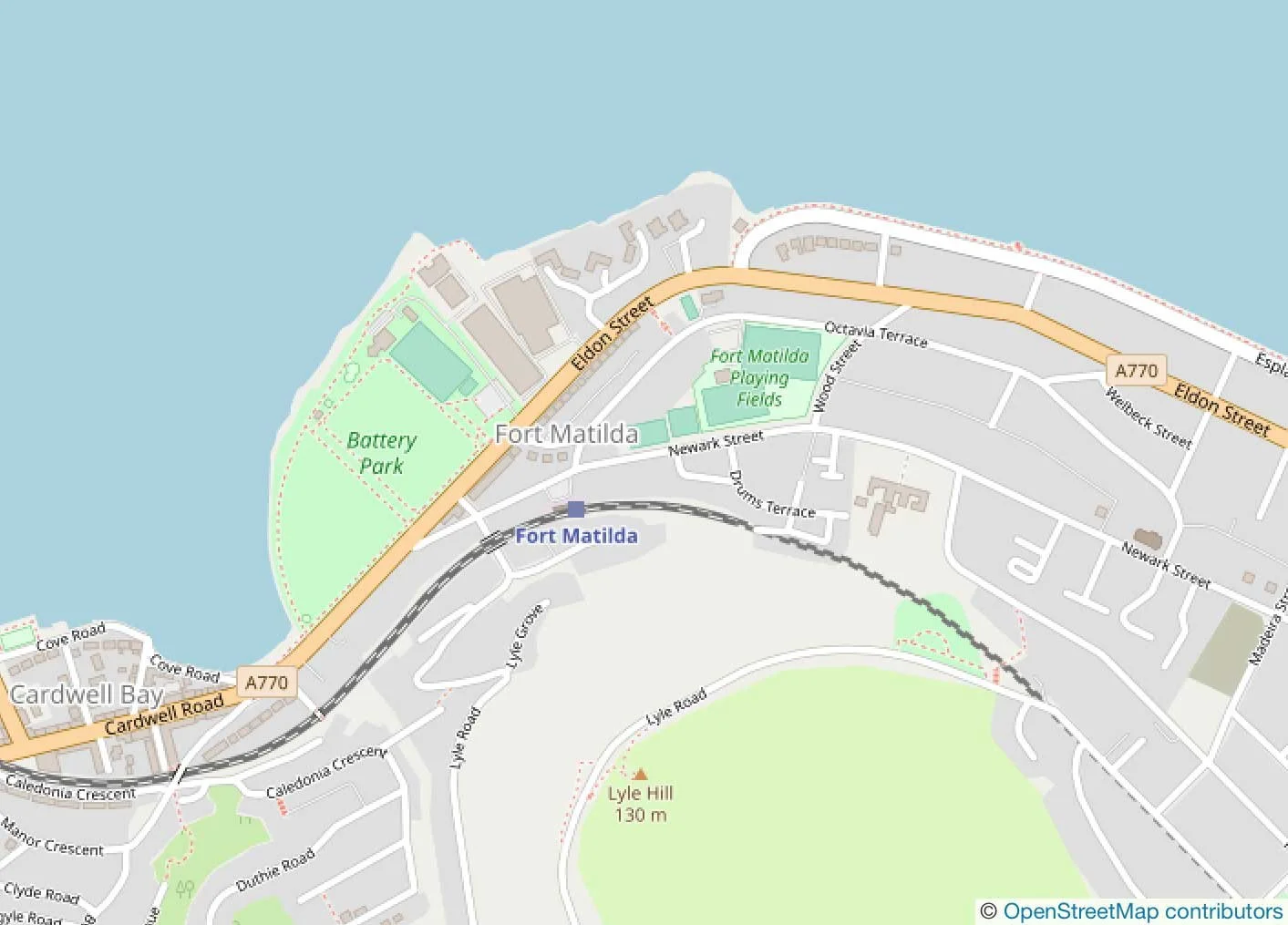Fort Matilda
by Joseph McGeer
The town and harbour of Greenock had, previously, been defended by two batteries. These had been located where the present container terminal now stands.
The first, Fort Beauclerc, was built circa 1760 as a consequence of the Seven Years War against France, Austria and Russia (1756-1763), when French warships were operating off Ailsa Craig. It was described as of ‘rude architecture’ and mounted twelve guns. It was strengthened in 1778 during the American War of Independence.
It was replaced in 1797 by Fort Jervis which mounted twelve 24 pounders in a regular breastwork of defence. Fort Jervis was demolished in 1809.
The Area of Fort Matilda © OpenStreetMap contributors which is made available here under the Open Database License (ODbL).
In 1813 Greenock magistrates wrote to the Commander-in-Chief for Scotland and the Board of Ordnance expressing their concerns about the defenceless state of the town and harbour, in consequence of the war with America (1812-1815). American war ships had already captured a number of merchant ships within a few days of their leaving the port.
Plans were drawn up in September 1813 for a battery of nine guns at Whitefarland Point and the site was acquired by the War Department on 4th April 1814, after the granting of a land feu, solely for a battery, by Sir Michael Shaw Stewart. Construction of an open battery for eleven smooth bore guns was completed in 1819. The fort was, most likely, named after the Princess Royal, Charlotte Augusta Matilda, first daughter of George lll.
In 1820 the fort was dismantled ‘in consequence of disturbed state of the country’ and the guns, carriages and ammunition taken to Dumbarton Castle. In 1852 the fort was stated as being in good condition, although it had no guns. By 1855 it was reported as being dilapidated.
The erection of a new fort by J. & W. Taylor of Glasgow started in January 1858 and was completed by December. Eight smooth bore guns arrived in July 1859.
A Queen’s birthday salute of 21 guns was fired on 24th May 1861 and a Royal salute fired for the Prince of Wales’ marriage on 10th March 1863. In 1879 the fort still had eight guns, (one 80 pounder, two 64 pounders, four 10 inch and one 68 pounder), but was surrounded by buildings and considered obsolete.
In 1880 a Committee on the Defence of the Mercantile Ports of the United Kingdom was set up under the chairmanship of Lord Morley (Under-Secretary of State for War). The resulting report, of July 1882, was considered by the Inspector General of Fortification who advocated a 'single line of defence' for the Clyde based at Fort Matilda where the river could be closed by submarine mines supported by batteries atBaron’s Point, Cove; the hill above Gourock; the hill above Fort Matilda, and at Portkil Point.
In September 1885 the guns, carriages and stores were removed and sent to Leith.
The construction of a submarine mining station and pier on the east side of the fort commenced in January 1886 and was completed by the end of the year. The contractor was Mr. Meikle of Ayr. The location and extent of the minefield is not now known, although there was a practice minefield in Portkil Bay, east of Kilcreggan.
After periods of training by the Submarine Miners it was customary to perform a display of submarine explosions. Reports exist of these events at Portkil Bay in 1891 and off Fort Matilda in 1904. In 1887 three 64 pounder rifled muzzle loading guns had been sent to the fort for drill and practice and in 1894 two 6 pounder quickfire guns and two Maxim machine guns were provided to cover the minefield.
It was decided, in 1899, that the fort should be remodelled again for two 4.7 inch quickfire guns to replace the 6 pounders. Construction started in March 1902 and the three 64 pounder and two 6 pounder guns were returned to Ordnance Stores.
Military Parade, Fort Matilda
In August 1903 Lord Roberts inspected the work being performed on the Clyde defences. The progress at Fort Matilda is described as follows:-
‘The alterations for the strengthening of the fortress are almost completed, the old battery has been demolished and on the site a new searchlight [there were two of them], magazine, engine [room] and dynamo [room] have been erected. There has been built a new gun emplacement, upon which two 4.7 guns will be mounted. The fort is enclosed by massive walls of concrete and is further protected by a large embankment in front.’
By July 1904, two 4.7 inch quickfire Mk. V guns were installed and two searchlights added. The two Maxim machine guns were retained. A battery at Portkil with two 4.7 inch guns, two 6 inch guns and two searchlights was completed the same year to cross fire with the guns at Fort Matilda.
The submarine mining establishment was abolished the same year although some of the buildings remain to this day on the right hand side of the former Navy Buildings entrance. In December 1912 the Mk. V guns were removed and returned to Woolwich, being replaced by two Mk.1V* guns. These were dismounted in February 1917 and sent to the Officer in Charge - Defensively Armed Merchant Ships at Princes Dock, Glasgow. By 1937 the two searchlights had been removed and the fort was subsequently demolished.
The site feu reverted to Sir W Guy Shaw Stewart of Ardgowan in 1945; however there had been an Admiralty research station started on the site in 1944 and completed by early 1947. An agreement concerning the original feu conditions was eventually reached with the Ardgowan Estates.
The new building, which was a large 4 story ‘unhardened’ red brick building designed in U shape, along with the remaining Submarine Mining Station buildings were retained within the secure compound and became known as the Navy Buildings. They housed the local office of the Maritime and Coastguard Agency, and were home to H.M.S. Dalriada, (a Royal Naval Reserve training centre) as well as a large number of other government departments and agencies. These included a meteorological office, the local tax office and the Soldiers’, Sailors’ and Airmen’s Families Association.
In September 2012, the property was placed on the market by the Ministry of Defence following the closure of the coastguard facilities based there. A number of options were considered for its future use. Following the demolition of Navy Buildings apartments were built on the site.
Fort Matilda Area, 2022
The name Fort Matilda, however, remains in use in Greenock being that of the nearby railway station. The railway ticket office building on the station platform is now occupied by the local model railway club.




